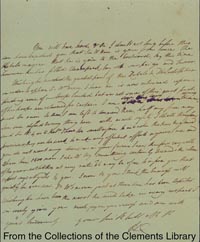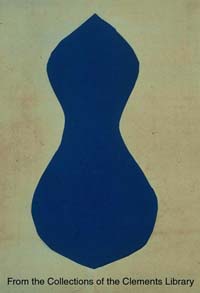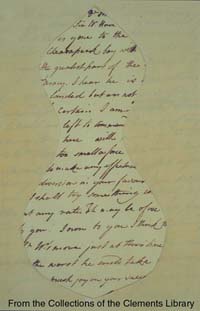John Burgoyne Surrenders
August 10, 1777 -- Henry Clinton
to John Burgoyne
 |
 |
 |
Sir Henry Clinton's August 10, 1777 letter to John Burgoyne illustrates Clinton's frustration with General William Howe's actions. For three weeks before Howe moved toward Philadelphia, Clinton tried to convince him to cooperate and meet up with Burgoyne. Howe, however, would not deviate from his plan. He left Clinton orders to cover Manhattan, Staten Island, Long Island, and the Highlands. Clinton received permission to move in favor of Burgoyne, but Howe did not leave him enough men to act.
Burgoyne's northern campaign was not successful, and the British arrived too late to help him. On September 19, Horatio Gates' forces checked Burgoyne's army in the First Battle of Freeman's Farm on the west side of the Hudson River. British reinforcements finally arrived in New York on September 24. Clinton moved against the Highlands with 3000 men on October 3. He captured two key forts and possessed the Highlands, but received word that Burgoyne was in serious trouble.
By October 7, Burgoyne was desperate for supplies and reinforcements. He took 1600 men, and headed to the American left. Horatio Gates' countermove and Benedict Arnold's assault on British forces forced Burgoyne to withdraw. The patriots then won the Second Battle of Freeman's Farm. Burgoyne withdrew northeastward about one mile, and on October 8 retreated to Saratoga. On October 13, Burgoyne, surrounded by a force three times the size of his own, asked for a cessation of hostilities. Clinton had already detached half his force in a desperate rescue attempt, but Burgoyne surrendered before Clinton's ships reached Albany.
The Saratoga Convention called for Burgoyne's
army to be marched to Boston and shipped to England with the understanding
that the men were not to fight again in the war against the colonies. Clinton's
success in the Highlands and Howe's success in Philadelphia were dramatically
outweighed by the Saratoga defeat.
|
Previous Story |
Next Story |
![]()
|
|
|
|
Letters | Stories | Methods | People | Routes | Timeline | Home
Clements Library | Sir Henry Clinton Collection | Teachers' Lounge | About the Project | Bibliography